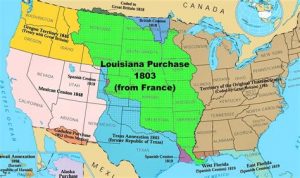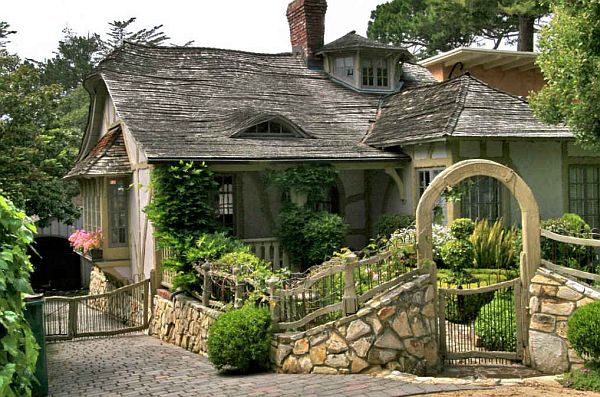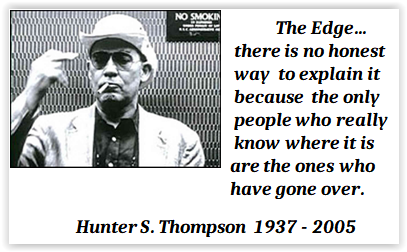If the shoe fits, this qualifies as a “teaching”…for those under 55.
The situation both American history finds itself in is one which my generation can do little about except to issue a heads-up and perhaps light a few flares and post trail signs in the wilderness you’re about to enter…once you decide to reorient your way back out of it in the three-generation (approximately 70 years) window Mother Nature allows.
From the bottom-up, History has only allowed this once.
As just noted, the trek out will be a multi-generational affair. But first you need to know “why” before you can even begin to understand the “how” of finding your way through the wilderness, a wilderness in part of your own making.
As the title implies, you must first know you are lost before you can seek to be found.
It begins with knowing the simple equations of a free society that have existed in our nation for over 400 years, and that they that need to be replicated and passed on; father-to-son, mother-to-daughter, parent-to-children.
There is such a thing as the American “Doctrine of Liberty”, but it swelled in people who lived for over 200 years before it was ever written down (by a fellow named George William Curtis, a co-founder of the Republican Party, and first delivered as an address to Phi Beta Kappa at Harvard—yes, that Harvard—in 1863, in support of President Lincoln’s Emancipation proclamation). All Curtis did was put he sentiment in writing.
The Doctrine was largely scuttled by the Republican Party by the end of the 19th Century, when the winners of the Civil War largely discovered capitalism via the Industrial Revolution. But it was never bred out of the ordinary Americans until the late 1960s, (3 generations ago) when the people ceded most of their power over their communities and the American to the federal government.
That was when the first plantings of the new wilderness took place, circa 1965.
So, we need to reacquaint ourselves with the idea of “wilderness” and how ordinary people first shaped law when they encountered.

It took 237 years to finish drawing the boundaries shown here, and another 60 years filling in the little dots in between. (I’d always hoped someone would turn this into a board game…anyone remember Risk?).
I don’t care where you live, or when your people got here, of how they got here. From Massachusetts to Oregon every dot on that map (above) was put there when it was largely surrounded by wilderness. And the sequence by which each of those dots grew, some to be mighty cities, others only county seats, and many, many times more small towns with no apparent particular purpose for being there other than at some date in the past some people parked themselves there and built a community…probably to farm, since, until the 1880s farming was the primary building block for almost every town in America. If you ever drive west, I-10, I-20, I-40, I-64, I-70, I-80, you will pass through open farmland and range, and today possibly wonder how people could ever stand to live there…mile after mile of farms and ranches, and every once and awhile, an exit to town big enough to be a county seat.
What you probably never considered is that the farms came first, sometimes as much as 30-40 years, and the county seat was built later, as a place to seat county government. It was also where all the businesses were situated, to service the farmers or ranchers and their employees, or mining enterprises, as the country moved westward.
If you’ve seen the film “Tombstone” you know that there was a town sheriff and a county sheriff, and later, even a federal marshal. If you’ve read any Mark Twain, in his book Roughing It, about his travels West after the Civil War, he mentioned Silver City, in Nevada, which was a boisterous mining town twenty years before Tombstone found silver and crime. I paraphrase, but he noted that Silver City had half a dozens saloons, three hotels, brothels galore…and almost as a postscript, “some talk of building a church”.
In short, most of those dots you see on the map were created bass-ackwards from the way you see your world today. “Order” always came before “law”, meaning that the rules that ran a community, sometimes for years, was little more than a common understanding of right and wrong, simple decency, and manners among the people. Farm towns were largely religious people, while male-only mining towns weren’t. Makes sense if you stop to think about it.
Bottom line, electing city councils, hiring sheriffs, and actually writing down laws, usually was the last thing that cemented the community. Not the first.
So, there was a very clear logic as to why those towns were built the way they were built, even as those reasons no longer apply to modern 21st Century societies. But at the barest bones there is both a logic and a history that applies to Americans that were never allowed to people of other nations to apply to themselves, for almost all their communities were built from the top-down, controlled by a ruler, dating as far back as the 9th Century.
(If you believe that America was divinely inspired, and I do, it was this condition that denied fully 80% or more of Mankind a mechanism whereby people could build their own governments, and pursue life, liberty and happiness “without the permission of the state” (as once told to me by some atheist Soviet college professors).
And the perfect condition for that to happen first occured here on our eastern shore in the early 1600s.
But if you believe America was divinely inspired, (I’ll be happy to debate anyone who says it was an accident…I have both serious and humorous monologues in rebuttal) it was never intended that we should keep the great secret-to-success to ourselves. (I was recently able to contribute a couple of chapters on that very point, called the “Thin Red Line”, to a very fine Biblical-philosophical history by David C Poff, Unwashed Philosophy: A User’s Guide for Our Imperfect Union, now available in paperback at Amazon.com)
America was “designed” to share this gift. Export it. Only, having spent more time with lower classes of Europe and Asia than have most of you, I found out “our way of doing things” and their way of doing things, were not the same. You couldn’t just give them an outline and say, “Here, do this.”
I was in the USSR when it fell in 1991-92, and the saddest thing was just as small businessmen in the Soviet Bloc thought the window had opened to allow them to grow their wealth “the American-way”, our “American way” was being largely abandoned in the worldwide corporate world. It was being totally redesigned both technologically and philosophically, even inspirationally, to reduce it to a set of numbers and equations, removing all the former precepts, such as moral reciprocity, even ethics, most of which involved that just-mentioned divine inspiration of people living together “reciprocally”.
Back in America, I gave lectures in Business Law to Soviet emigres, all professional and seeking employment here. They had a difficult time understanding several basic precepts, such as “contracts”. To them its was a written document by which they must abide, always written by the other party. The USSR had contracts too, you see. I racked my brain, and finally came up with English Common Law, circa 1400s, and the notion that a contract began as a “handshake”; that the contract is a written understanding between two people expressing in writing what they already understood with that handshake. Mano-y-mano.

It was as if a bolt of lightning had come out of the sky. “Da, da, da. Of course. Now we understand kontrakt.”
In short, there was (still is, I think) a level of reciprocity between people who had had their histories and social customs erased over three generations earlier and no outside agency (e.g., the United Nations agencies) neither knew how to re-insert, nor, quite frankly, even knew to consider. By the time the Soviet Union fell, after 75 years, that sort of reciprocity had been shrunk to only inside the family (or in some cases, criminal gangs), which is a very tribal, even pagan way of life to be bequeathed by a departing government.
The people of eastern Europe, especially the Balkans, with which I am even more familiar, luckily had only had two generations erased instead of three, so there was some memory that lingered. I noted this when I observed an octogenarian great-grandmother trying to teach her great-grandchildren how to cross themselves, kneel and genuflect, at a recently reopened Orthodox church in Bulgaria. Neither those children’s mothers nor grandmothers had any memory of the Church. But it had not been totally lost.
I have known many Balkan men in America, retired steel workers, and the like, who told me of the great “tribal-religious hatreds” between Orthodox and Catholics in what was Yugoslavia since 1919, their villages taking sides in World War II largely based on those hatreds. They could kill each other without remorse, and with the full blessings of their respective churches…that mutual hatred going back to the Fourth Crusade in 1204 (that’s right, 700+ years), when Latin (Catholic) crusaders sacked (Orthodox) Constantinople.
Still, two sons of migrants who emigrated to Chicago in 1930s, one a Roman Catholic from Zagreb, the other Eastern Orthodox from Sarajevo, had worked side by side in the steel mills in Gary, Indiana and were best friends for 30 years. This was told to me by John Stamat, the man from Sarajevo, who pointed this “idiosyncrasy” out to me, sitting on his front porch in Clarkdale, Arizona, where he had come to retire, next door to my dad.
What I do know is that whatever America’s “secret recipe for success” is, it came from the bottom up. Although the intentions were good, the best we could do was JFK’s Peace Corps, which attracted almost exclusively the upper classes of society, who could spend 2-3 years in some far-off Third World patch, showing people of the African Sahel how to dig better wells and irrigation ditches, and thereby earn themselves a social merit badge.
But by the 1990s, a full generation, that lost its social luster.
Understanding the origins, natural history, of this wilderness is just the first step.
To be Continued.








 It is said that wisdom is “the quality of having experience, knowledge, and good judgment. “ I am of the opinion that there are far more people in the world that consider themselves "lovers of wisdom" (philosophers) than there are those that actually possess it.
At her founding, the American Nation had already amassed 150 years of " national" wisdom; our first-of-its-kind Nation, built from the bottom up (as opposed to the top-down construction of every previous nation in humankind's history), and the Framers understood that the single-most-important ingredient necessary for her long-term survival was the freedom, liberty, and right to self-determination of the Sovereign Individual of which she would necessarily be comprised.
Join us, or follow along as we take a closer look at these notions.
It is said that wisdom is “the quality of having experience, knowledge, and good judgment. “ I am of the opinion that there are far more people in the world that consider themselves "lovers of wisdom" (philosophers) than there are those that actually possess it.
At her founding, the American Nation had already amassed 150 years of " national" wisdom; our first-of-its-kind Nation, built from the bottom up (as opposed to the top-down construction of every previous nation in humankind's history), and the Framers understood that the single-most-important ingredient necessary for her long-term survival was the freedom, liberty, and right to self-determination of the Sovereign Individual of which she would necessarily be comprised.
Join us, or follow along as we take a closer look at these notions.
 Vassar Bushmills
Vassar Bushmills
As always, well done my friend! And one for the ages